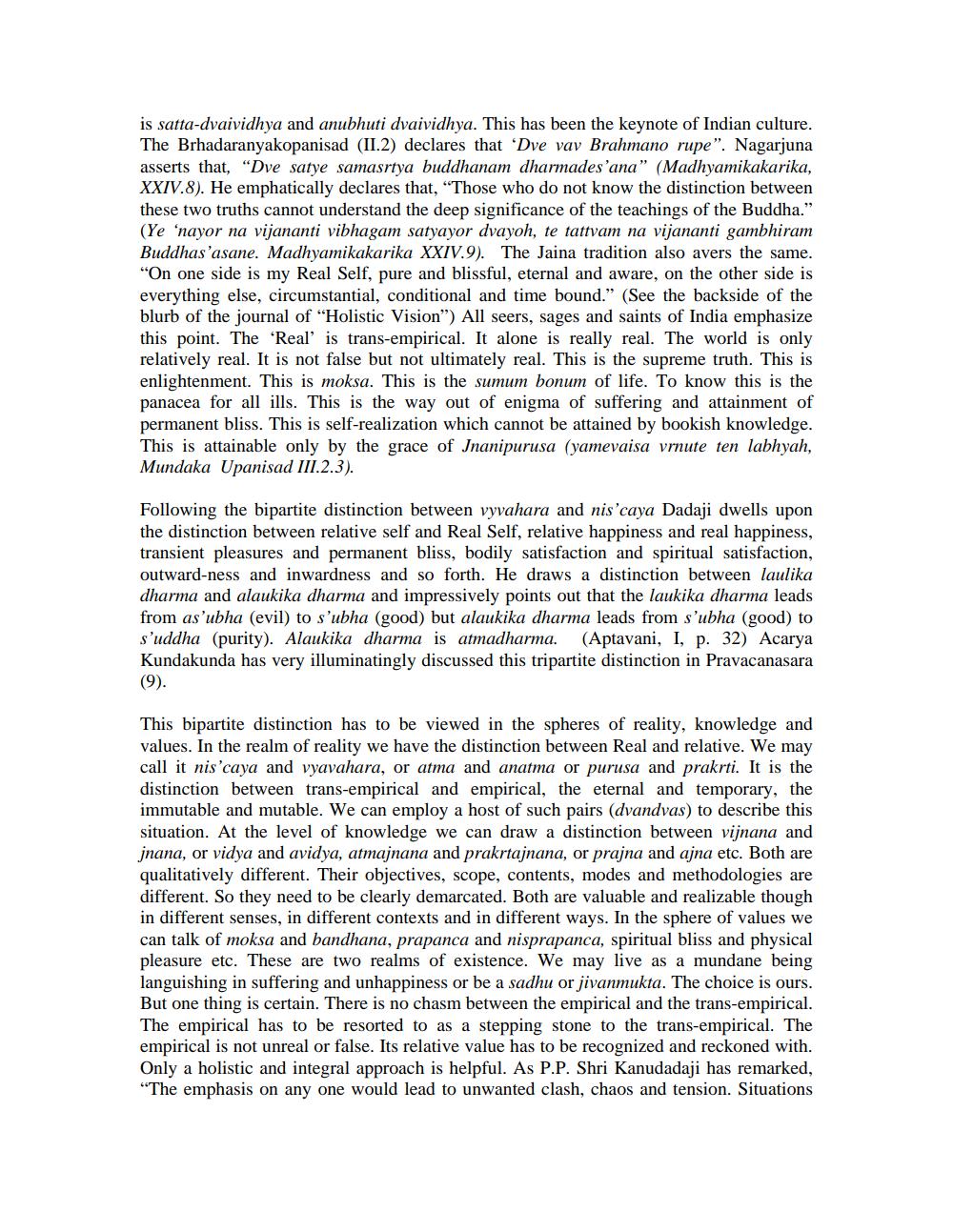Book Title: Concepts of Parmatma Antaratma Anatma in Philosophy of Dada Bhagwan Author(s): S R Bhatt Publisher: S R Bhatt View full book textPage 9
________________ is satta-dvaividhya and anubhuti dvaividhya. This has been the keynote of Indian culture. The Brhadaranyakopanisad (II.2) declares that "Dve vav Brahmano rupe". Nagarjuna asserts that, "Dve satye samasrtya buddhanam dharmades 'ana" (Madhyamikakarika, XXIV.8). He emphatically declares that, "Those who do not know the distinction between these two truths cannot understand the deep significance of the teachings of the Buddha." (Ye 'nayor na vijananti vibhagam satyayor dvayoh, te tattvam na vijananti gambhiram Buddhas'asane. Madhyamikakarika XXIV.9). The Jaina tradition also avers the same. "On one side is my Real Self, pure and blissful, eternal and aware, on the other side is everything else, circumstantial, conditional and time bound." (See the backside of the blurb of the journal of "Holistic Vision") All seers, sages and saints of India emphasize this point. The 'Real' is trans-empirical. It alone is really real. The world is only relatively real. It is not false but not ultimately real. This is the supreme truth. This is enlightenment. This is moksa. This is the sumum bonum of life. To know this is the panacea for all ills. This is the way out of enigma of suffering and attainment of permanent bliss. This is self-realization which cannot be attained by bookish knowledge. This is attainable only by the grace of Jnanipurusa (yamevaisa vrnute ten labhyah, Mundaka Upanisad III.2.3). Following the bipartite distinction between vyvahara and nis'caya Dadaji dwells upon the distinction between relative self and Real Self, relative happiness and real happiness, transient pleasures and permanent bliss, bodily satisfaction and spiritual satisfaction, outward-ness and inwardness and so forth. He draws a distinction between laulika dharma and alaukika dharma and impressively points out that the laukika dharma leads from as'ubha (evil) to s'ubha (good) but alaukika dharma leads from s'ubha (good) to s'uddha (purity). Alaukika dharma is atmadharma. (Aptavani, I, p. 32) Acarya Kundakunda has very illuminatingly discussed this tripartite distinction in Pravacanasara (9). This bipartite distinction has to be viewed in the spheres of reality, knowledge and values. In the realm of reality we have the distinction between Real and relative. We may call it nis'caya and vyavahara, or atma and anatma or purusa and prakrti. It is the distinction between trans-empirical and empirical, the eternal and temporary, the immutable and mutable. We can employ a host of such pairs (dvandvas) to describe this situation. At the level of knowledge we can draw a distinction between vijnana and jnana, or vidya and avidya, atmajnana and prakrtajnana, or prajna and ajna etc. Both are qualitatively different. Their objectives, scope, contents, modes and methodologies are different. So they need to be clearly demarcated. Both are valuable and realizable though in different senses, in different contexts and in different ways. In the sphere of values we can talk of moksa and bandhana, prapanca and nisprapanca, spiritual bliss and physical pleasure etc. These are two realms of existence. We may live as a mundane being languishing in suffering and unhappiness or be a sadhu or jivanmukta. The choice is ours. But one thing is certain. There is no chasm between the empirical and the trans-empirical. The empirical has to be resorted to as a stepping stone to the trans-empirical. The empirical is not unreal or false. Its relative value has to be recognized and reckoned with. Only a holistic and integral approach is helpful. As P.P. Shri Kanudadaji has remarked, "The emphasis on any one would lead to unwanted clash, chaos and tension. SituationsPage Navigation
1 ... 7 8 9 10 11 12 13 14 15 16 17 18 19 20 21 22 23 24
